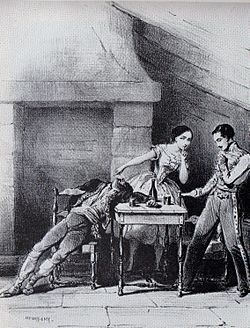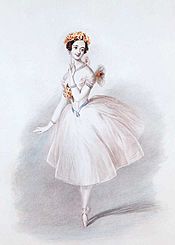Paquita facts for kids
Quick facts for kids Paquita |
|
|---|---|

(left to right) Georges Ellie as Iñigo, Carlotta Grisi as Paquita, and Lucien Petipa as Lucien d'Hervilly in Act I, Scene 2. Paris, 1844
|
|
| Choreographed by | Joseph Mazilier |
| Composed by | Edouard Deldevez |
| Libretto by | Joseph Mazilier and Paul Foucher |
| Date of premiere | 1 April 1846 |
| Place of premiere | Salle Le Peletier, Paris |
| Original ballet company | Paris Opera |
| Characters | Paquita Iñigo Lucien d'Hervilly |
| Setting | Act 1: Gypsy camp Act 2: Great hall |
| Created for | Carlotta Grisi |
| Genre | Ballet-pantomime |
| Type | Romantic ballet |
Paquita is a beautiful romantic ballet with two acts and three scenes. A ballet is a type of dance performance that tells a story through movement and music. The story for Paquita was created by Joseph Mazilier and Paul Foucher. The music was written by Edouard Deldevez.
The ballet was first performed in Paris, France, on April 1, 1846. It was shown at the Salle Le Peletier by the Paris Opera Ballet. The main dancers were Carlotta Grisi and Lucien Petipa. Paquita was performed regularly by the Paris Opera until 1851.
The Story of Paquita
The story of Paquita takes place in Spain. This was during a time when Napoleon's army was in the country. The main character is a young Gypsy girl named Paquita. She doesn't know it, but she was actually born into a noble family. She was kidnapped by Gypsies when she was a baby.
Paquita saves the life of a young French officer named Lucien d'Hervilly. A Spanish governor wants Lucien dead and has asked a Gypsy chief, Iñigo, to kill him. Paquita bravely stops this plan. Later, Paquita finds out that she is from a noble family. She discovers that she is actually Lucien's cousin! In the end, Paquita and Lucien fall in love and get married.
Paquita in Russia
In 1847, Paquita was performed for the first time in Russia. It was staged for the Imperial Ballet of St. Petersburg by Marius Petipa and Pierre-Frédéric Malevergne. This was a very important moment because it was the first ballet Marius Petipa ever staged in Russia. He later became a very famous ballet master.
In 1881, Marius Petipa brought Paquita back to the stage. He added new music and dances to the ballet. These new parts were specially created by the composer Ludwig Minkus. Some of the famous new sections included:
- The Pas de trois (also known as the Minkus Pas de trois or Paquita Pas de trois) for the first act.
- The Grand pas classique for the last act. This is a very famous and challenging dance for many dancers.
- The Mazurka des enfants (Children's mazurka).
Petipa's updated version of Paquita was performed at the Mariinsky Theatre until 1926.
Paquita's Legacy Today
Even though the full Paquita ballet was not always performed, the new parts that Marius Petipa added in 1881 became very popular. Today, these pieces, especially the Grand pas classique, are important parts of classical ballet. Ballet companies all over the world still perform them. They are often shown in ballet galas or as a way to show off a dancer's skills.
In 2001, a ballet master named Pierre Lacotte created a new version of the full, two-act Paquita for the Paris Opera Ballet. He brought back many of Joseph Mazilier's original story-telling parts and stage designs. He also included Marius Petipa's famous additions from 1881.
| Romantic Ballets |
|---|

The Ballet of the Nuns (1831) |
Images for kids
See also
 In Spanish: Paquita (ballet) para niños
In Spanish: Paquita (ballet) para niños










